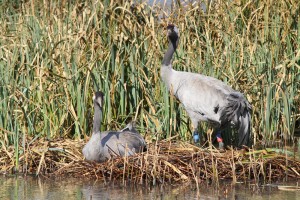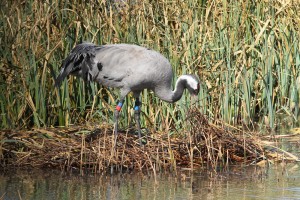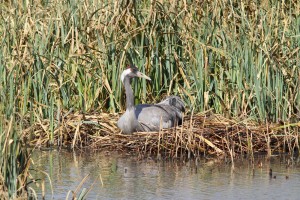First crane nests in the South West in 400 years

 Common cranes are nest building in the South West of England for the first time in 400 years, after being reintroduced to the region by the Great Crane Project.
Common cranes are nest building in the South West of England for the first time in 400 years, after being reintroduced to the region by the Great Crane Project.
Cranes are large and colourful birds who perform amazing courtship dances and trumpeting calls. They were driven to extinction across Britain by the 1600s through hunting and the draining of wetlands.
The Great Crane Project began in 2010 with the aim of reintroducing this important bird to its former native habitat. This is the first time that any of the young birds have attempted to build a nest – they have had no opportunity to learn from other birds in the wild – so while it may come to nothing, the innate behaviour they are exhibiting is a milestone for the Project.
The birds were raised at WWT Slimbridge by aviculturists who dressed as adult cranes to teach them to survive, whilst also being fearful of humans. For the last three years the young birds have then been released onto the Somerset Levels where Project staff have worked with local landowners to create an environment in which they will hopefully thrive.
 The birds occasionally fly out and back to Somerset and four have chosen to stay further up the Severn Estuary at Slimbridge, near where they were hatched. Two of these are building a nest in clear view of one of the WWT reserve’s hides, creating a very rare experience for birdwatchers who are unlikely to be able to get near a nesting crane anywhere in the world.
The birds occasionally fly out and back to Somerset and four have chosen to stay further up the Severn Estuary at Slimbridge, near where they were hatched. Two of these are building a nest in clear view of one of the WWT reserve’s hides, creating a very rare experience for birdwatchers who are unlikely to be able to get near a nesting crane anywhere in the world.
The Project is a partnership between WWT, the RSPB and Pensthorpe Conservation Trust with major funding from Viridor Credits Environmental Company, who share the vision to return this beautiful bird to where it once belonged.
Great Crane Project Aviculturist Amy King – who is the ‘mum’ who dressed as an adult crane to teach the birds survival skills – said:
“This beautiful bird was so iconic to Britain yet it was wiped out through hunting and the draining of our wetlands. It may come to nothing but this is an amazing moment seeing their first nest-building attempt in this part of the world for 400 years. It’s even more exciting knowing these are some of the same birds we taught by hand to survive by themselves. I feel like a very proud parent!”
The RSPB's Tony Whitehead said:
"This is really encouraging news and its great to see the birds at least getting the idea of nest building even if they don't get to egg laying! Both here and with the flock in Somerset it's going to be a fascinating few years and I for one can't wait to see the first birds hatch in the wild. And it's always worth remembering - this is much about the quality of the wetlands the project is helping provide as it is about the birds. If we get these birds back it'll speak volumes about efforts of conservationists and farmers who are working hard to get things just right for these marvellous birds.
The four birds who are staying around Slimbridge are from the first ‘crane school’ graduates in 2010 – one male known as Monty, and three females known as Chris, Sedge and Ruby. Click here to see which coloured rings each has on their leg so you can tell which one is which in the photos.
 Monty and Chris have paired up to build the nest and have also shown mating behaviour. The nest is clearly a reasonable attempt because Monty and Chris have had to repel the local mute swans from attempting to move in on their prime real estate. They have also become less tolerant of Sedge and Ruby, and even attacked Sedge when she has come near. Whether there is any connection between this and the fact that Monty had been displaying to Sedge in Somerset last year, who knows?
Monty and Chris have paired up to build the nest and have also shown mating behaviour. The nest is clearly a reasonable attempt because Monty and Chris have had to repel the local mute swans from attempting to move in on their prime real estate. They have also become less tolerant of Sedge and Ruby, and even attacked Sedge when she has come near. Whether there is any connection between this and the fact that Monty had been displaying to Sedge in Somerset last year, who knows?
The Project is particularly exciting at this point because it is entering the unknown. The birds had never seen Slimbridge from the air before, so why were they attracted to go there while all the other cranes have chosen to stay on the Somerset Levels?
This type of behaviour has rarely been seen close up before so the fact that the birds’ first steps towards nest building are taking place in a location where both conservationists and the public can comfortably watch from a hide is remarkable. Pictures of the cranes nesting has captured the media’s imagination, with national newspapers and radio stations all intrigued to see these amazing birds back in the wild in Britain.
The timing of the nest building attempt is great not just for their ‘mum’ Amy King, but also their proud ‘dad’, WWT Conservation Breeding Officer Roland Digby, as he is briefly back in the country between an expedition to Madagascar helping to save the Madagascar pochard from extinction, and an expedition to Russia where he’s doing the same for the Spoon-billed sandpiper.